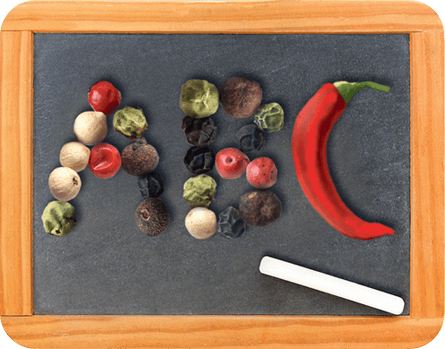Generally Speaking …
Spices are the bark, root, fruit, or berry of a tropical, perennial plant.
Herbs are the leaves of annual and perennial shrubs that grow in the temperate zone.
Seeds are derived from annual plants and include anise, caraway, cardamom, celery, coriander, cumin (comino), dill, fennel, mustard, poppy, and sesame.
Seasonings are blends of spices, herbs, seeds and/or salt and other flavors.
Dehydrated vegetables consist of onion, bell peppers, garlic, and parsley.
… But All Are Commonly Referred To As Spices.
What to Look for When Buying Spices
The three most important factors are strength, color, and aroma. The best way to judge strength is by comparing old stock to new, for freshness. The difference is remarkable! The color, should be bright, not faded. The aroma should reach your nose before your nose reaches the container. Some attributes that buyers look for when purchasing spices are volatile oil content, heat units, ASTA color, and mesh size.
Where to Store Spices
Cool dry areas away from bright light are the best choice. Flavor is lost when spices are exposed to heat, and even the least amount of moisture can cause caking. Paprika and some herbs are light sensitive, so it’s preferable, for their appearance, to store them away from strong, direct light. And don’t forget to close the container tightly after each use. An open container promotes flavor loss.
Why Spices Need to be Replaced
Weak scented spices waste your cooking time as well as the other ingredients in the recipe. Using additional quantities of weak spices does not compare to using the correct quantity of fresh spice either in flavor or appearance. Herbs and spices that have faded in color would be undesirable when used as a garnish.
When to Replace Spices
Whole spices have a longer shelf life than ground spices and herbs. The general rule of thumb for ground spices, herbs, and seasonings is to replace them after 18 months. Or you can give them a sniff test — if you can’t smell the product when it’s a few inches away from your nose you certainly won’t be able to taste it.
How Much Spice to Use, and When
It’s always easier to add more spice than to try to remove it, so start with a pinch (approximately 1/4 teaspoon) of dried herbs per four servings. To help release the flavor it’s helpful to crush whole herbs with your fingers before adding it to a recipe. In foods with long cooking times, it’s best to add herbs during the last hour of cooking; or if whole spices are called for, add them at the beginning of cooking. (It’s helpful to place them in a small cheese-cloth so they can be removed when the desired flavor is reached. This also avoids any pieces of whole spice from remaining in the finished dish). Otherwise, add spices at the time the recipe calls for salt. In uncooked foods, herbs should be added as long as possible before serving.
Scaling Up Recipes
Restaurants and institutions often need to size up recipes for larger gatherings. Here are some suggestions for increasing spice in formulas. They are only suggestions.There’s no real substitute for testing the quantity batch.
Spices: When doubling recipes, double allspice, cloves, cinnamon, black and white pepper, etc. Nutmeg and mace are exceptions that require the herb formula.
Seasonings: Double the recipe, double the seasoning.
Herbs: For the first 100% increase in the portions, double the amount of herbs. For each multiple thereafter, add only half of the original amount of herbs.
Ground Red Pepper: This item merits special attention, as the heat intensity increases quickly. For the first 100% increase, double the amount of red pepper. For each multiple thereafter, add a fourth the original amount.
